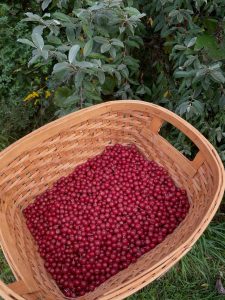
There is one Hardy Banana Tree(Musa basjoo) that will survive year after year in cold climates( down to USDA Zone 5). The catch is that it does not fruit or flower in cold climates, and even if it did, the fruits are not edible. So why is this plant featured on Eat The Planet if it does not get bananas? Because the gigantic leaves are used in cooking around the world. The way Japanese Banana manages to live through cold climates is that all the foliage dies down to the ground in the winter, the deep roots stay alive below the frost line, the next summer the tree grows full size again up to an astonishing 10’-15′ by the end of the summer. The best way to make sure the Hardy Banana stays alive is to pile mulch or wood chips on, about 3’ high after the foliage dies in the fall. This wild edible is not native to the United States but you can buy 2 Musa Basjoo Banana Trees Here. This is a plant that I personally am excited about because of my own experience. The photo featured on this page is my specimen of japanese hardy banana growing in Zone 5b in southern new england. We cover the roots with mulch in the winter and it grows to about 12′ in the summer.
Culinary Use
The gigantic leaves can get to be 6’ long and 18” wide. Banana leaves are used around the world to wrap up meals and steam them inside the leaves. Some examples are Mexican Tamales, South American Pasteles, India’s Idlis, Filipino Bibingka, there are many more recipes using banana leaves to cook food. The banana leaf imparts a flavor onto the food and keeps the flavors of the food contained. Banana leaves are often used to steam fish with other veggies or spices, they are also often used to make different types of doughy meals sometimes with meat and veggies stuffed in the dough. There are also some other less known uses for the plant. The liquidy trunk contains starch that is extracted and used as a flour substitute. If you can manage to get the plant to flower maybe in a greenhouse then the nectar can be drunken and has a sweet flavor.
Health Benefits

Banana leaves contains polyphenols which are antioxidants found in many plant based foods including green tea. So cooking your food in banana leaves would infuse your meal with additional antioxidants. This ancient method of cooking is healthier that using plastic or tinfoil and people have been doing it for thousands of years.
Conclusion
Obviously the Hardy Japanese Banana does not grow wild in North America or Europe, it originated in Japan and has been propagated all over the world, primarily for fibers or for ornamental use because of its tropical looking foliage. There are a few specialty retailers online so it is easy to find and purchase. This isn’t a typical plant I would feature but I have one growing at my house and am amazed every year at how large it grows and many people don’t even know they exist. If I had a nickel for every time I got a comment on that banana tree I’d be a millionaire. I have also found the leaves to be useful anytime I need a natural place mat or want to cook something the tropical way.
Many of our readers find that subscribing to Eat The Planet is the best way to make sure they don't miss any of our valuable information about wild edibles.
See our privacy policy for more information about ads on this site







7 Responses
Have been growing the Musa Basjoo “hardy banana” and transplanting the pups for 3 summers in Ohio! They are absolutely beautiful and I wish I had a nickel for every time someone made a comment about them! I have them planted around my pool.
wow, you got them growing in ohio, thats a little colder then where i am in CT. did you say they make it through the winter there or no? they do here if you put a heavy layer of mulch on top.
WE grow the Hardy banana trees here in the state of Oregon USA. Grants Pass for 4years. We too cover the roots with mulch and leaves in winter. We would to learn as much as we can about them. we have taken up the pups and replanted them around the yard and around our fish pond. and even given to friends . Everyone just fall in love with the trees. THANK YOU FOR YOUR ARTICALS Yvonne
Love the look of the Japanese Hardy Banana! I’m in search of a tropical/lush looking plant(s) for extremely large fixed planter boxes (built out of block and stone veneer), but they have concrete bottoms. The planters are 4 foot deep. Would you consider this an acceptable permanent “home” to plant the hardy banana if covered with mulch over the winter? We live in Missouri. The frost line here is considered 3 feet deep. I wasn’t sure if the root system required the ability to grow deep, which I couldn’t offer, but thought I would ask your opinion. Thanks!
It’s definitely worth a try. They aren’t too expensive but I would be a little concerned that they would not make it through the winter because the box basically exposes all sides to the elements.
I grow them in Illinois. Cover them with about 3′ of leaves inside a chickenwire circle. Seems to work fine.
Mine have bananas this year! NJ near Philly…